There are a lot of different kinds of brushes available in the market, and they differ mainly based on the shape of the bristle and the material the bristles are made of.
In terms of the material used for the bristles, it is made of either animal hair or synthetic fibres mimicking the characteristics of animal hair brushes or even a mix of both.
In this post we are going to go deeper into what to expect from these different types of paint brushes and how to choose the right brush for you!
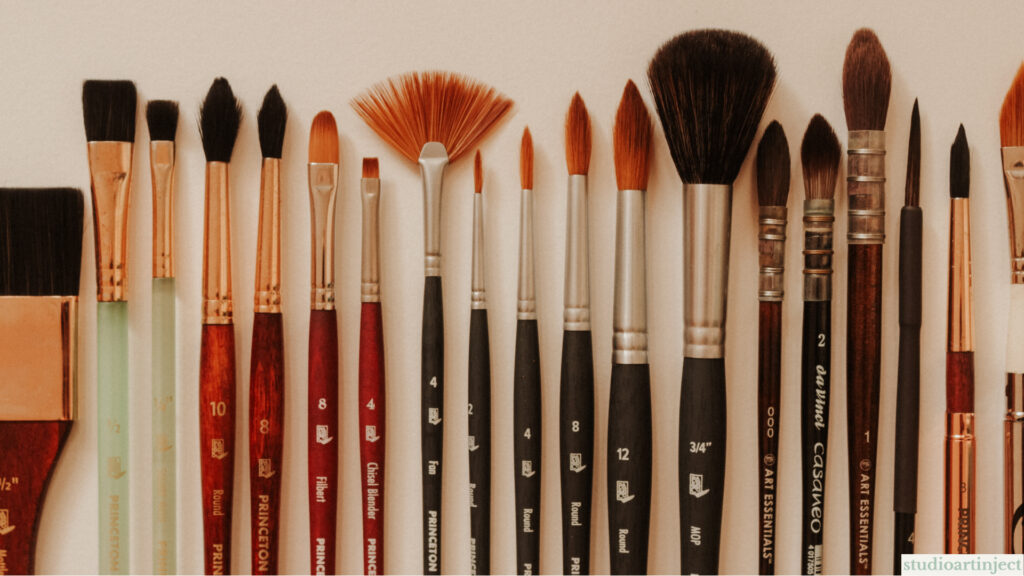
Types of Paint Brushes based on the Material of Bristles of the Brush
Watercolour brushes are made of soft bristles while acrylic and oil brushes are made of snappier bristles.
Watercolour Brushes
The bristles of watercolour paint brushes are often made with animal hair because it is soft and tends to hold more water(+pigment). Watercolour brushes have soft bristles, a round or flat ferrule to attach the bristles to the handle, and a short handle made of wood or bamboo.
I have personally not found anything lacking in a synthetic hair brush or felt the need to buy natural hair brushes. There are a myriad variety of high-quality synthetic substitutes available in the market that are engineered to mimic the structure and performance of the various natural animal hair brushes.
Sable Hair/ Synthetic Sable Brushes
They are known for their soft yet springy bristles which can hold a heavy load of paint+water. Sable brush bristles are flexible and come to a very fine point.
Squirrel Hair/ Synthetic Squirrel Brushes
They don’t come to as sharp a point as sable brushes do and are definitely not springy like them, but squirrel brushes have extremely soft bristles which can hold a lot of water.
Goat Hair/ Synthetic Goat Brushes
Traditionally used in Chinese Brush painting and for calligraphy, these brushes are a popular choice for watercolour wash brushes (Japanese Hake brushes) due to their softness and ability to hold a large amount of paint+water. Goat brushes like squirrel brushes lack spring, but unlike the former, it comes to a fine point.
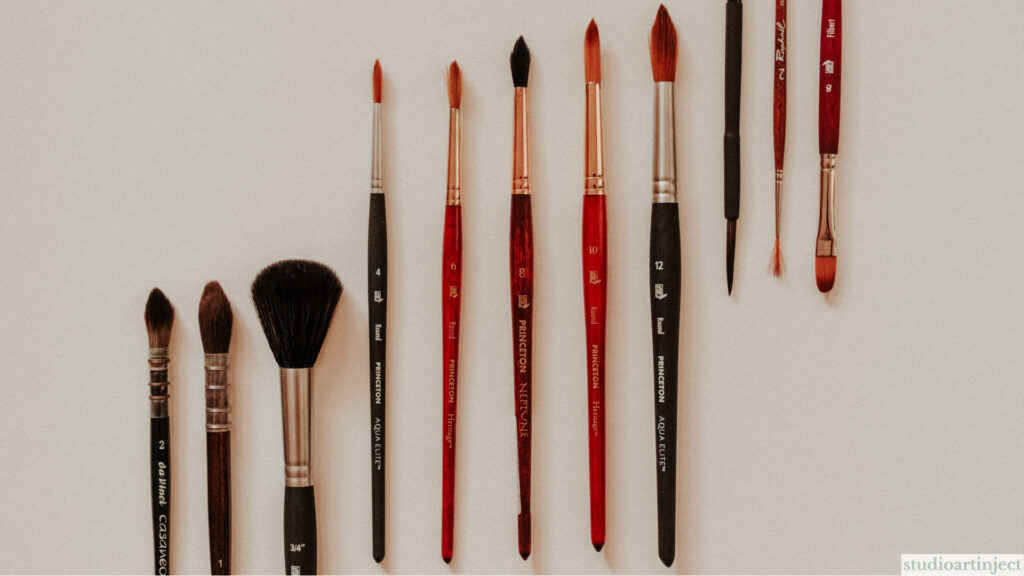
Acrylic Brushes
The bristles of acrylic paint brushes are often made with synthetic materials like synthetic sable, synthetic hog, taklon, nylon and polyester to withstand the relatively harsh usage of acrylics. The use of palette knives is also very common when painting with acrylics.
Synthetic Sable
Synthetic sable brushes are a good choice for the smooth application of paint and blending.
Gold Taklon
These brushes hold their shape and maintain their points even with rough usage. Acrylic paints can be harsh on the brushes because of not only their composition but the constant need for it to be vigorously rubbed out of the brushes when changing colour during use.
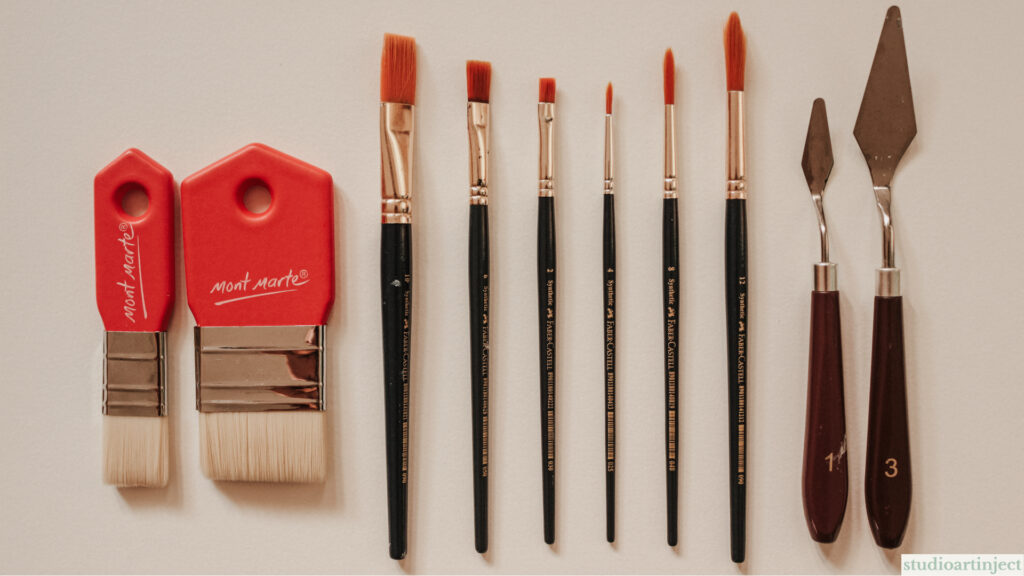
Oil Brushes
Hog Hair/ Synthetic Hog Brushes
Hog brushes have strong but springy bristles, which become softer with more use. The bristles have natural split ends which allow them to hold more paint and create textured marks.
White Taklon
Although hog brushes are the primary choice for oil painting to scrub the paint onto the canvas and create bold expressive marks, a synthetic brush is required when painting with thinned-down paint and making detailed elements. A White Taklon brush, while softer than Gold Taklon, has stiff bristles and is a good choice in synthetic brushes for oil painting.
Types of Paint Brushes based on the Shape of the Brush
The various paint brushes are classified on the basis of the type of bristle it has-
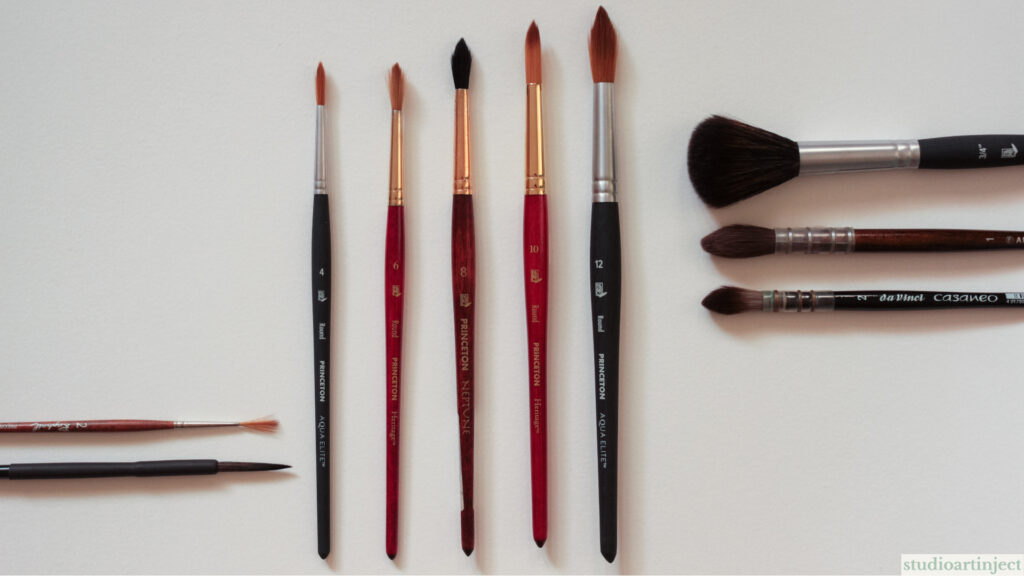
Round Brush
Round brush is the most versatile paintbrush because of its fat belly which tapers to a thin tip. It can be used to create thin line-work with its tip and thick strokes with its belly. And therefore can create dynamic lines and detailed work.
A sub-category of a round brush is a Quill/ Mop brush which is basically a round brush on steroids. It can hold an incredible amount of paint+water. It can cover a large area to act as a wash brush but is equally capable of creating fine lines and details with its tip.
Another sub-category of a round brush is a Liner/ Rigger Brush which is a brush with long and thin bristles, designed to create very thin and precise strokes. This brush is a little tricky to handle, one advantage of that is that it helps in producing beautiful organic lines when you’re not trying too hard to control it.
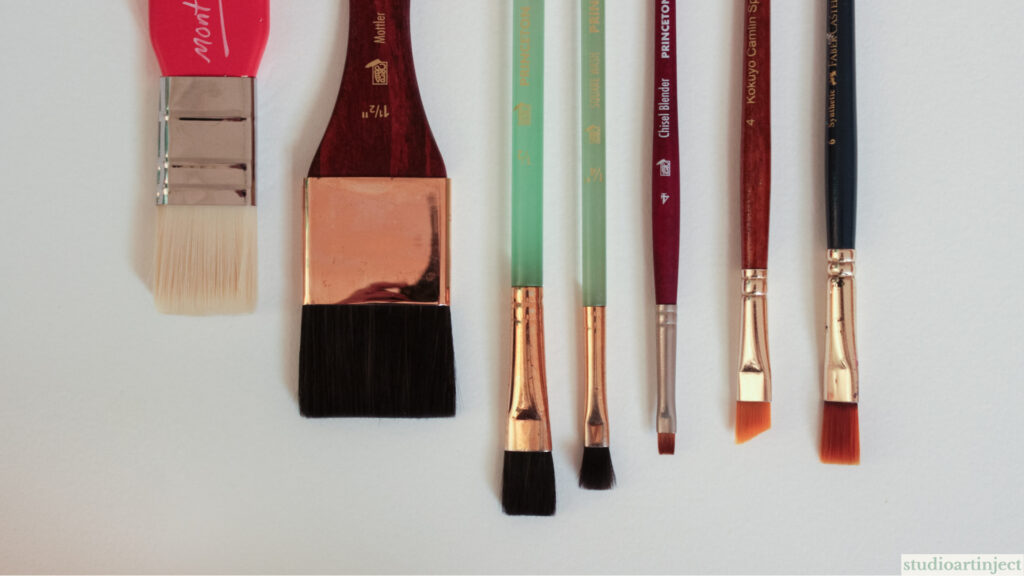
Flat Brush
Flat brush is used to fill larger areas, paint loose bold strokes, make boxed strokes, straight edges with its chiselled tip, and create even lines making use of the flat edge of the brush.
A sub-category of a flat brush is a Bright/ Blender Brush which is essentially a flat brush with shorter bristles, shaped like a square rather than a rectangle, therefore providing more control over the strokes.
Another sub-category of a flat brush is an Angular Brush which is a flat brush with an angled edge, which enables you to vary the thickness of the stroke and add precision.
Filbert Brush
It is a hybrid between a round and a flat brush. the bristles are flat with a flat ferrule, but a rounded tip. It packs the qualities of both brushes to provide an impressionistic stroke.
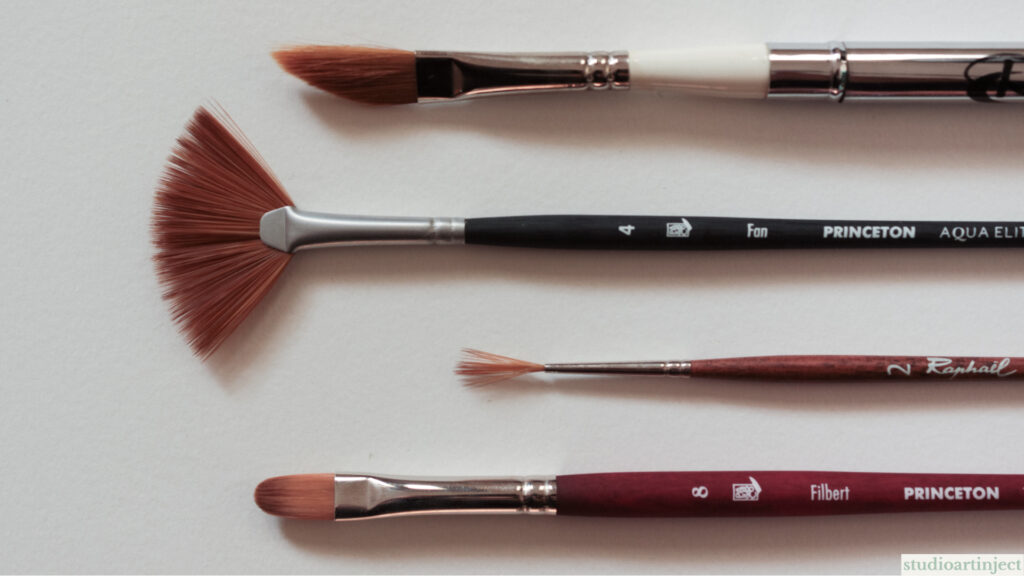
Speciality Brushes
There are many speciality brushes that are available in the market to make it easier for artists to paint specific subjects by facilitating ease of creating specific strokes by virtue of the design of the brush itself. Three such brushes are discussed below:
Fan Brush is designed to create very specific strokes. It’s an interesting addition to your toolkit to create textures in for instance your landscape paintings.
Sword/ Dagger Brush is again, like all speciality brushes, designed to create very specific strokes. It creates leaf-like strokes and is therefore commonly used to make floral paintings.
Cat Tongue/ Oval pointed has a belly like that of a flat brush, coming to a tip like a round brush. It can create washes like a flat brush and details like a round brush, and mimicks the potential of a quill brush whilst providing more control.
Apart from round brush, quill/mop brush and flat brush, all other brushes are speciality brushes and are used to achieve very specific strokes.
How to Choose the right size of Paint Brush
As far as the size of the brush is concerned, the size you choose to buy will depend on the following:
- the size of the paper or canvas you are painting in
A larger surface area will require the use of a bigger size brush and a smaller surface area will require the use of a smaller size brush.
- the size and intricacy of the subject you are painting
If you are painting a loose subject you will probably use a bigger size brush, and if you are painting a detailed subject then you will probably opt for a smaller size brush.
Watercolour Brushes to carry when Travelling
When travelling, paint brushes need to be carried in a brush roll to protect the bristles of the brush from getting deformed, and to ensure that it maintains its shape.
Unlike acrylic and oil brushes which can only be protected using a brush roll when travelling, watercolour brushes are available in the form of travel brushes. Travel watercolour brushes are constructed to have the bristles, ferrule and 1/3rd of the handle as the first unit, and the remaining 2/3rd of the handle as the second unit. The second unit acts as a lid for the first unit when not in use, and at the time of use the second unit can be attached at the end of the first unit to complete the handle of the brush.
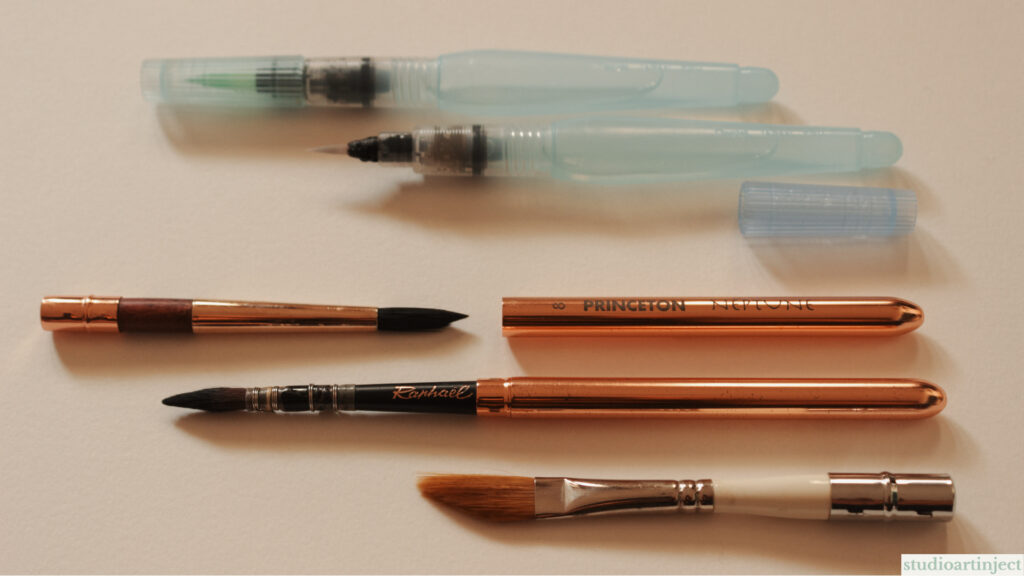
There is another type of brush made for watercolour painting when travelling, i.e. a Water Brush. Water brushes generally have synthetic nylon bristles. They are structured like a pen, with a water reservoir forming the handle/ body, and a cap to protect the bristles. The water reservoir eliminates the need to separately carry a container to hold water which makes it extremely accessible.
When it comes to selecting brushes for the purpose of painting on location, I recommend carrying three brushes- one small round (size 4/6), one large round (size 8/ 10/ 12), and one flat brush (size 6/8).
A paintbrush is seen as an extension of one’s hand and therefore picking the right one is an extremely personal choice.
[P.S. This post contains links to supplies that I trust and use, to help you choose the best supplies for yourself. Some of those links are affiliate links, meaning if you make a purchase through those links then I may earn a small commission at no extra cost to you. It is a little something that helps support my art practice and the creation of free resources such as this. Thank you!]